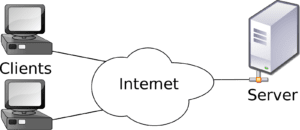| Previous | Next |
| WININET_E_CANNOT_CONNECT | WININET_E_CONNECTION_RESET |
WININET_E_CONNECTION_ABORTED
The most common reasons of WININET_E_CONNECTION_ABORTED (0x80072efe) are a firewall or anti-virus interfering with the connection, a proxy borking the connection data. I can also be caused by a name resolution issue — for example, if the host name resolves to 127.0.0.1 locally and the web server is bound to the public IP address only. Another possibility; the server at the far end may be filtering (and dropping) requests based on browser agent strings, to prevent programmatic scraping.
The reason of WININET_E_CONNECTION_ABORTED error can be also an application crash. For example, the Event Logs can indicate that w3wp.exe (the IIS App Pool) had crashed and with Visual Studio, it can be found that reason is “The thread used up its stack”. So the reason of error is a StackOverflowException that was crashing the app pool.
Client–server model
Client-server model is a distributed application structure that partitions tasks or workloads between the providers of a resource or service, called servers, and service requesters, called clients. Often clients and servers communicate over a computer network on separate hardware, but both client and server may reside in the same system. A server host runs one or more server programs, which share their resources with clients. A client usually does not share any of its resources, but it requests content or service from a server. Clients, therefore, initiate communication sessions with servers, which await incoming requests. Examples of computer applications that use the client-server model are email, network printing, and the World Wide Web.
Client and server communication & WININET_E_CONNECTION_ABORTED
 Generally, a service is an abstraction of computer resources and a client does not have to be concerned with how the server performs while fulfilling the request and delivering the response. The client only has to understand the response based on the well-known application protocol, i.e. the content and the formatting of the data for the requested service.
Generally, a service is an abstraction of computer resources and a client does not have to be concerned with how the server performs while fulfilling the request and delivering the response. The client only has to understand the response based on the well-known application protocol, i.e. the content and the formatting of the data for the requested service.
Clients and servers exchange messages in a request–response messaging pattern. The client sends a request, and the server returns a response. This exchange of messages is an example of inter-process communication. To communicate, the computers must have a common language, and they must follow rules so that both the client and the server know what to expect. The language and rules of communication are defined in a communications protocol. All protocols operate in the application layer. The application layer protocol defines the basic patterns of the dialogue. To formalize the data exchange even further, the server may implement an application programming interface (API). The API is an abstraction layer for accessing a service. By restricting communication to a specific content format, it facilitates parsing. By abstracting access, it facilitates cross-platform data exchange.